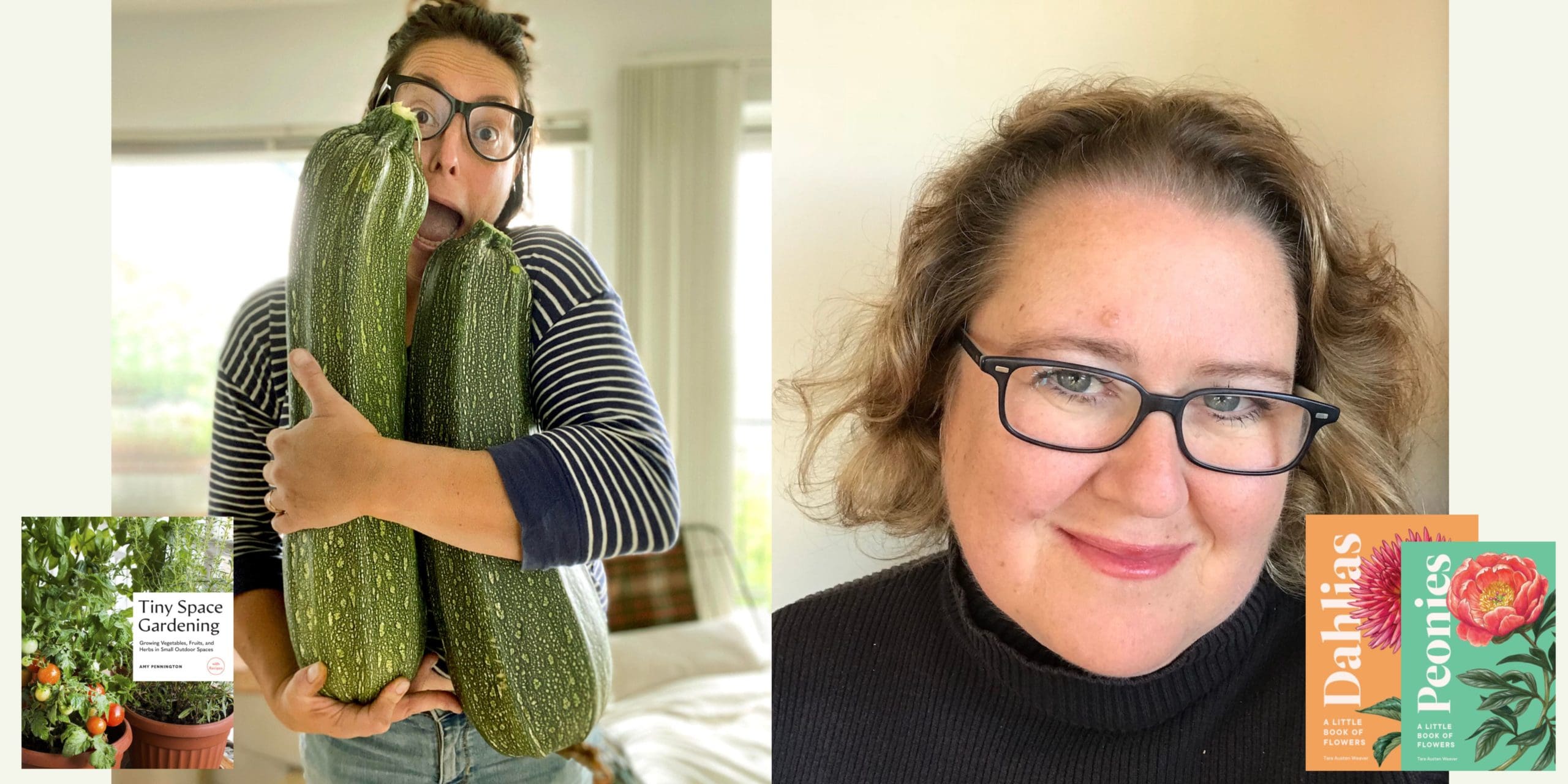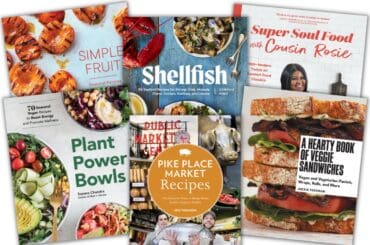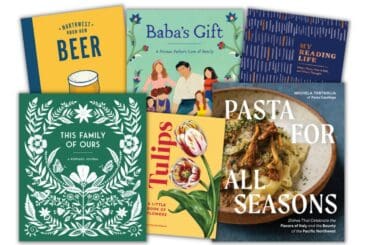Spring has sprung! What better way to ready a garden than with gardening tips from the experts. We asked authors Amy Pennington of Tiny Space Gardening and Tara Austen Weaver of Dahlias and Peonies their thoughts on everything from why and how to start a garden (even if you don’t have a yard!) to garden must-haves and the pitfalls gardeners should avoid.
Why garden?
Amy: Ha! Gardening connects us with the natural world. It slows people down and lulls them into a sense of calm. While I didn’t plan to be in touch with nature, over the years I’ve developed a sixth sense for temperature, weather, and seasonal change. I even notice small changes in pressure. Gardening can bring us sustenance–we are growing our own food by tending a garden! We are practicing self-sufficiency. We are cultivating environmental stewardship. This is why we should garden. The flowers and food are pretty sweet rewards too.
Tara: There are lots of reasons to garden—to grow food, to make things more beautiful, to reduce your carbon footprint and mitigate climate change. But most of the people I know garden because it is deeply enjoyable and helps them slow down and connect with nature. It’s rewarding in so many ways.
If someone wants to get into gardening, where do you recommend they start?
Tara: I think herbs are the place to start, especially if you like to cook. There is great satisfaction—and not much effort required—in having fresh herbs. They can even be grown in a window box or planter on your deck. You will save so much money (and plastic packaging) by not buying those bundles of herbs for a recipe when all you need is three sprigs.
Amy: Start small. If you have a small indoor or patio space, start with a few containers. If you have land, start with one garden bed. Visit a nursery and just pick whatever plants call to you, learning how best to care for them. (Not all plants require the same care!) From there your interests will grow. You may want to try other plant families or grow trees instead of leafy plants. Think of your first year of gardening as casual experimentation and see where your green thumb leads.
What is the first thing a gardener should do to get ready for spring?
Amy: A new gardener should gather equipment and prep in the months leading up to spring, if possible. Containers, potting soil, and fertilizer are all you really need to get going. If you’ve been growing plants in small spaces for some years, consider refreshing the soil and adding some rich compost.
Tara: Make a plan! I’m not great at this because I usually want to jump in, but you should decide what you want to grow and where, and how much time and energy you have for the project. And be honest, so you don’t plan too big and end up resenting your garden. Next step: Assess your soil and decide if you need to add anything before planting.
What are some pitfalls new gardeners should avoid?
Tara: It’s good to understand that you can only successfully grow things that are suited to the conditions you have. Soil quality and sunlight dictate a lot—and it’s best not to set yourself up for failure. If you have shady areas, you’re not going to be able to grow tomatoes there (they won’t thrive). Seek out plants that match your garden—and maybe grow the tomatoes in pots on a sunny deck or driveway, if you have one.
Amy: Biting off more than they can chew. Often people decide “I want a garden,” and spend a lot of time and money gathering plants and then get home and feel overwhelmed. I encourage everyone to start small and build from there. It’s always a good time of year to grow something, so there are plenty of windows of opportunity.
What if someone has limited space or no yard to garden?
Amy: There are some fast and easy countertop projects for anyone with no access to space. I sprout seeds of all kinds once every two weeks or so. It’s basically salad in a jar! You can also grow a small sheet of microgreens without the outdoors or much sunlight. Citrus trees (and fruit!) grow well indoors when placed in a warm, sunny window—Key limes, Meyer lemons—and their blooms are so wildly fragrant.
Tara: For limited space, I think vertical—peas, beans, cucumbers, cherry tomatoes, even squash can be trained up supports, and any number of vining flowers. But also make sure to grow what you absolutely love and will enjoy. If you have no yard, gardening is still possible. I started out with a box of herbs hanging off a third-floor apartment windowsill. If you have a sunny spot indoors, pots of herbs, flowers, and microgreens are all options.
What can you grow on an apartment balcony?
Tara: I’ve seen some impressive balcony gardens—with adequate sunlight and enough (and large) pots you can grow any number of things: lettuce, spinach, tomatoes. I’ve seen eggplant and broccoli, raspberries and blueberries. Pots dry out faster with container gardening than in-ground plantings, so make sure you have a plan to keep everything watered, especially if you go out of town in the summer.
Amy: Definitely salad! Most people get hung up on one or two heads of lettuce, but if you plant a variety of seed (speckled, red, frilly, flat) you can grow some pretty beautiful and flavorful greens. The curcubits family (which includes cucumbers) also does well on balconies, thanks to their shallow root system and propensity to grow up, saving space. Cucumbers are a personal fave. Flowers. Always beneficial to invite pollinators into the garden and provide food for bees.
Ok, fill in the blank, your garden wouldn’t be complete without ___?
Amy: Attention and care and rose geranium. I always make sure to grow scented geraniums which I use year-round.
Tara: It’s impossible to pick one! Herbs, raspberries, greens, and dahlias are all my top picks for my garden.
Amy, Tiny Space Gardening is an updated and expanded version of your wildly popular Apartment Gardening. What can gardeners look forward to in this new edition?
An expanded list of “What to Grow,” including most common herbs and vegetables. A new section dedicated to growing fruit trees in pots. Modern growers have cultivated root stock that produces small, aka “dwarf,” trees that thrive in pots and have significant production! It’s pretty amazing to grow apples on a balcony.
Tara, tell us about your new Little Book of Flowers series.
I fell in love with dahlias when I moved to the Northwest. They grow so well here—producing bright and colorful flowers from mid-summer until first frost. Peonies have always been a favorite—the gorgeous, elegant blooms of spring. In this series we look at how to grow the flowers, but also their cultural background (which is fascinating), how best to pick them, dry them, arrange them, even make drinks from them (peony petal syrup is delicious). And the books are beautifully illustrated by Emily Poole, illustrator of Bird Note. They’re perfect gifts for anyone who loves flowers—even experienced gardeners will learn something new. And the next book in the series is tulips!







